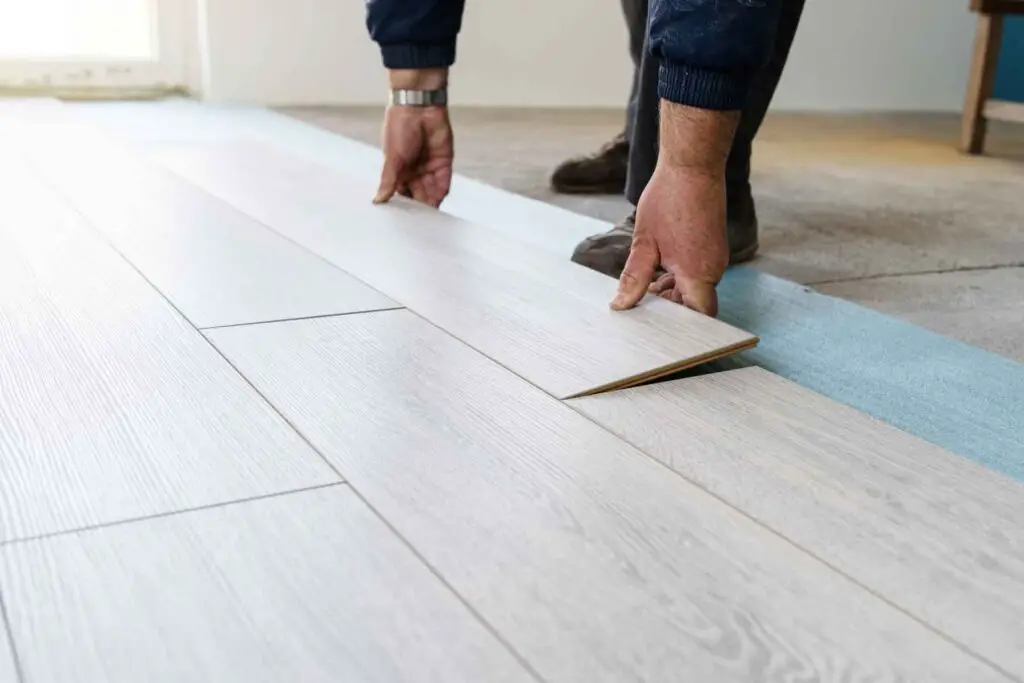When you walk across your room, there’s an odd sensation underfoot that’s hard to ignore – your laminate flooring feels spongy. This issue, while not uncommon, can be a frustrating and confusing problem for homeowners.
The cause of this sponginess can be traced back to several potential issues, each requiring a unique solution. This guide aims to explore the reasons why your laminate flooring feels spongy and offers practical solutions that you can consider to restore the solidity and comfort of your floor.
Causes of Spongy Laminate Flooring

Credit: Getty Images
Improper Installation
One of the most common causes of spongy laminate flooring is improper installation. Laminate floors need to be installed on a smooth and level surface.
If the subfloor is uneven, it can cause the laminate boards to flex and give that spongy feeling underfoot. Additionally, if the laminate boards were not properly locked together during installation, gaps can form, causing sponginess.
In these cases, the solution may involve repairing the underlying subfloor or reinstalling the laminate flooring correctly.
Poor-Quality Laminate
Another prevalent cause of a spongy feel in your laminate flooring may be the use of poor-quality laminate. Low-grade laminate usually lacks the necessary firmness and density, leading to increased flexibility.
This flexibility, while it may seem advantageous during the installation process, can lead to a spongy sensation when walked upon due to the laminate’s inability to withstand constant foot traffic.
Resolving this issue might necessitate the replacement of the existing laminate with a higher-quality one, designed for superior durability and rigidity, thereby eliminating the spongy feeling.
Moisture Issues
Moisture is a significant concern when it comes to laminate flooring feeling spongy. If the underlayment or the subfloor beneath the laminate gets damp or excessively humid, it can cause the laminate to swell and create a spongy sensation.
This is especially common in areas with high humidity levels or if there has been a water spill that wasn’t properly cleaned up. The moisture can loosen the adhesive holding the laminate in place, causing it to shift and have a soft or spongy texture.
In such cases, it is necessary to identify the source of the moisture and rectify it. This could involve improving ventilation, using dehumidifiers, or in severe cases, replacing the affected sections of the laminate flooring.
Subfloor Problems
Problems with the subfloor are another significant factor contributing to the spongy feel of laminate flooring. These issues can range from an uneven subfloor surface to inadequate or damaged underlayment.
An uneven subfloor can lead to certain areas of the laminate flooring not being fully supported, leading to a spongy sensation when stepped on.
On the other hand, if the underlayment, which provides a cushion between the subfloor and the laminate, is compromised, it may not offer the necessary firmness and support, leading to a spongy feel.
Therefore, adequately preparing the subfloor before laminate installation is crucial, including ensuring its level and using quality underlayment.
Problems Associated with Spongy Laminate Flooring
Aesthetics
While laminate flooring is admired for its aesthetic appeal and versatility, a spongy feel can significantly detract from its overall appearance and feel. The surface may seem irregular and unsteady, affecting the smooth and polished look that laminate flooring is known for.
This can be particularly noticeable in high-traffic areas of the home, where the spongy spots may cause visible dips and rises in the flooring.
What’s more, the spongy sections might lead to a misalignment of the laminate boards, disrupting the continuous pattern and flow, thereby diminishing the aesthetic charm of the flooring.
Safety Concerns
A spongy feel to laminate flooring can also pose serious safety concerns. Uneven or shifting surfaces may lead to tripping hazards, particularly in homes with elderly residents or young children.
The unstable surface can also cause slips if the laminate moves unexpectedly when walked on. Beyond physical safety, spongy laminate flooring can also be indicative of more serious underlying issues such as water damage or mold growth.
In these cases, it’s not just the integrity of the floor that’s compromised, but it could potentially affect the health of the residents.
Potential Damage to the Subfloor
Spongy laminate flooring can potentially be a sign of underlying damage to the subfloor. Laminate flooring, by nature, is thin and relies heavily on a solid, level subfloor to maintain its rigidity and feel.
If the laminate feels spongy or soft, it may be an indicator of subfloor irregularities or even damage. Cracks, rot, and moisture can all compromise the subfloor, leading to soft spots that transfer through to the laminate flooring.
Furthermore, constant pressure and movement on these spongy areas can exacerbate the damage to the subfloor, increasing the likelihood of costly and extensive repairs.
Solutions to Consider for Spongy Laminate Flooring

Professional Assessment and Replacement
When laminate flooring feels spongy, it is highly recommended to seek professional help for an accurate assessment. Flooring experts are equipped with the required knowledge and tools to identify the root cause of the issue.
Whether it’s moisture, subfloor damage, or improper installation causing the sponginess, a professional can diagnose the problem accurately and provide the best solution.
In cases where the damage is extensive, replacement might be the most viable option. Hiring a professional for the replacement ensures that the new laminate flooring is installed properly, thereby preventing future spongy spots.
They will ensure that the subfloor is prepped and level, the moisture barrier is effectively installed, and the laminate boards are aligned correctly, providing a firm, attractive, and long-lasting flooring solution.
Addressing Moisture Issues
Moisture serves as one of the most common culprits behind a spongy feel in laminate flooring. If moisture penetrates the underlayment, it can cause the subfloor to expand, thus creating soft, spongy areas.
Addressing these moisture issues is crucial to restore the firmness of your laminate flooring and prevent further damage.
Firstly, ensure to promptly clean up any spills and avoid excessive use of water while cleaning your laminate floors.
Secondly, consider investing in a dehumidifier in humid climates to reduce the amount of moisture in the air that could potentially infiltrate your flooring.
Regularly checking your home for leaks, especially in areas like the kitchen or bathroom where moisture generation is high, can also prevent unwanted moisture seepage into the subfloor.
In the event of substantial moisture damage, it might be necessary to remove the affected laminate flooring to allow the subfloor to thoroughly dry.
Always remember to fix the source of moisture before reinstalling or replacing the flooring. A properly installed moisture barrier can be highly effective in preventing moisture from reaching the subfloor, thus protecting your laminate flooring from becoming spongy in the future.
Checking and Fixing Subfloor Issues
Another possible cause for a spongy feel in laminate flooring is the condition of the subfloor. It’s imperative to thoroughly examine your subfloor for any irregularities, such as dips or bumps, as these can lead to instability of the laminate, creating a spongy effect.
To check the level of your subfloor, you can use a long straightedge or a laser level. If you identify any uneven spots, they should be addressed immediately to prevent further issues.
As for fixing the subfloor, several methods are depending on the issue. For minor irregularities, a self-leveling compound can be applied to create a perfectly flat surface.
If the subfloor has larger dips, filling them with a layer of plywood might be necessary. In the case of severe damage where the subfloor is rotting or crumbling, the affected sections may need to be completely replaced.
Related Topics:
Prevention Tips for Spongy Laminate Flooring
Regular Maintenance
Regular maintenance is key to preventing your laminate flooring from feeling spongy. This includes keeping the floor clean and dry at all times, as water and dirt can seep into the cracks and cause damage to both the laminate and the subfloor.
Regularly sweep or vacuum your floor to remove dirt and debris, and clean up any spills immediately to prevent water from seeping into the laminate layers. Use a damp mop to clean, but avoid excessive water.
Besides, you should also consider using a laminate floor cleaner to remove tough stains without harming your floor’s surface.
Choosing High-Quality Laminate
When selecting laminate flooring, the primary aspect to consider is its quality, as this significantly influences the floor’s resilience against sponginess. High-quality laminate flooring tends to have a thicker construction, which gives it a firmer feel underfoot and makes it less prone to the spongy effect.
Look for laminate that comes with a high Abrasion Class (AC) rating, as this indicates a greater resistance to wear and tear, enhancing its longevity. Also, opt for a laminate that includes an attached underlayment.
This added layer can provide additional stability and help to smooth out minor subfloor irregularities.
Moreover, the quality of the laminate’s locking system plays a critical role in preventing a spongy feel. A superior locking system ensures a tight fit between planks, minimizing movement and providing a solid footing.
Remember, while higher quality laminate might come with a higher price tag, it can save you from future repair costs associated with inferior flooring alternatives. So, investing in a high-quality laminate floor can be a wise decision for long-term floor performance and aesthetics.
Proper Installation Techniques
Proper installation is just as crucial as choosing high-quality laminate when it comes to preventing a spongy feel underfoot.
Firstly, ensure that the subfloor is clean, dry, and level. Any unevenness in the subfloor can cause the laminate to bend or flex when walked upon, resulting in a spongy sensation. Use a level to check the floor, and if necessary, employ a self-leveling compound to correct any irregularities.
Secondly, consider using an underlayment. Although some laminate comes with pre-attached underlayment, an additional layer can further stabilize the floor and absorb sound.
Underlayment types include foam, cork, and felt, each offering different levels of moisture resistance and sound absorption.
The actual installation of laminate involves careful alignment and secure locking of the planks. Always follow the manufacturer’s instructions to ensure the correct laying pattern and locking technique.
Avoid gaps between the planks as they can lead to unnecessary movement and a spongy feel.
Finally, allow for an expansion gap around the perimeter of the room. Laminate flooring expands and contracts with changes in temperature and humidity, and without an expansion gap, this can lead to buckling or a spongy floor.
Conclusion
In conclusion, a spongy feel to your laminate flooring can be attributed to several factors – improper installation, use of low-quality laminate, moisture issues, or problems with the subfloor.
Each of these issues requires a unique solution, from repairing the subfloor to replacing poor-quality laminate with a denser, higher-quality one. Remember, prevention is better than cure – proper installation, regular maintenance, and choosing high-quality laminate can save you from future problems.
However, if you do encounter a spongy floor, it is best to consult a professional who can accurately identify the root cause and provide the optimal solution.
FAQs
Can I fix a spongy laminate floor without replacing it?
Yes, in some cases, a spongy laminate floor can be fixed without replacement. If the issue is due to improper installation, such as inadequate expansion gaps, then adjusting these gaps can solve the issue. However, if the sponginess is due to severe moisture damage or problems with the subfloor, you might need to replace the affected planks or the entire floor.
How can I prevent my laminate flooring from becoming spongy?
Preventing laminate flooring from becoming spongy involves a few key steps. Firstly, ensure proper installation according to the manufacturer’s instructions, including the use of underlayment and allowing for expansion gaps around the perimeter of the room. Secondly, choose high-quality, dense laminate to avoid issues related to low-quality material. Lastly, regular maintenance and prompt handling of any moisture-related issues can also help in preventing a spongy floor.

1 thought on “Why Your Laminate Flooring Feels Spongy and Solutions to Consider”